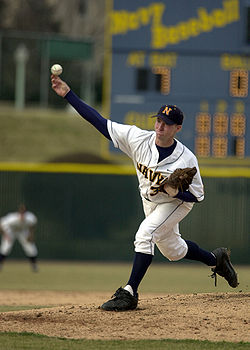Pitcher's mound
In roughly the middle of the square, equidistant between first and third base, and a few feet closer to home plate than to second base, is a low artificial hill called the pitcher's mound. This is where the pitcher stands when throwing the pitch. Atop the mound is a white rubber slab, called the pitcher's plate. It measures 6 inches (15 cm) front-to-back and 2 feet (61 cm) across, the front of which is exactly 60 feet, 6 inches (18.4 m) from the rear point of home plate. This peculiar distance was set by the rulemakers in 1893, not due to a clerical or surveying error as popular myth has it, but intentionally (further details in History section). In Major League Baseball, a regulation mound is 18 feet (5.5 m) in diameter, with the center 59 feet (18.0 m) from the rear point of home plate, on the line between home plate and second base. The front edge of the pitcher's plate or rubber is 18 inches (45.7 cm) behind the center of the mound, making the front edge's midpoint 60 feet 6 inches (18.4 m) from the rear point of home plate. Six inches (15.2 cm) in front of the pitcher's rubber the mound begins to slope downward. The top of the rubber is to be no higher than ten inches (25.4 cm) above home plate. From 1903 through 1968, this height limit was set at 15 inches, but was often slightly higher, sometimes as high as 20 inches (50.8 cm), especially for teams that emphasized pitching, such as the Los Angeles Dodgers, who were reputed to have the highest mound in the majors. A pitcher will push off the rubber with his foot in or

er to gain velocity toward home plate when pitching. In addition, a higher mound generally favors the pitcher. With the height advantage, the pitcher gains more leverage and can put more downward velocity on the ball, making it more difficult for the batter to strike the ball squarely with the bat. The lowering of the mound in 1969 was intended to "increase the batting" once again, as pitching had become increasingly dominant, reaching its peak the prior year; 1968 is known among baseball historians as "The Year of the Pitcher". This restrictive rule apparently did its job, contributing to the hitting surge of modern baseball. A pitcher's mound is difficult for groundskeepers to maintain. Usually before every game it is watered down to keep the dust from spreading. On youth and amateur baseball fields, the mound may be much different from the rulebook definition due to erosion and repair attempts. Even in the major leagues, each mound gains its own character, as pitchers are allowed to kick away pieces of dirt in their way, thereby sculpting the mound a bit to their preference. The pitcher may keep a rosin bag on the rear of the mound to dry off his hands. Major league baseball teams are also permitted cleat cleaners on the back of the mound. This may be a flat grate-style plate, or simply a hand tool such as a piece of wood used to remove mud and dirt from cleats. These items are allowed to remain on the backside of the mound at the discretion of the umpire, thus reducing the probability that they will affect a live play.